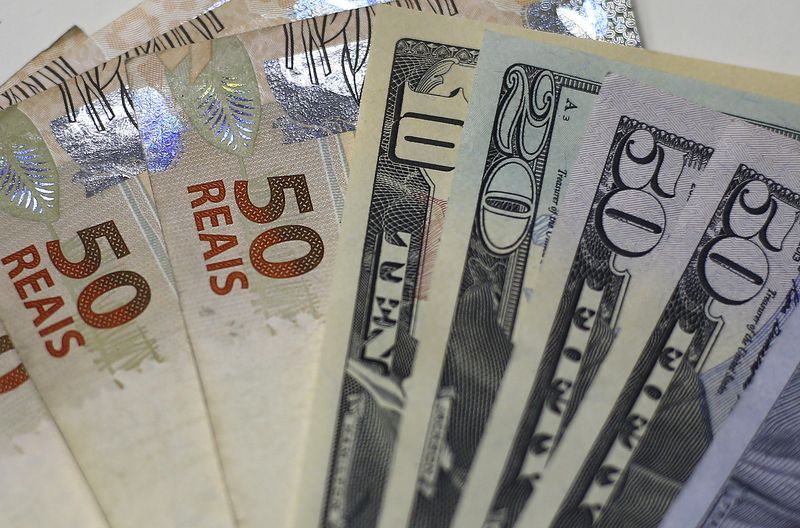By Marcela Ayres and Fernando Cardoso
BRASILIA (Reuters) - Brazil's currency reversed course and weakened against the U.S. dollar on Thursday, despite a larger-than-expected interest rate hike by the central bank and its signal of more aggressive increases ahead.
After opening the session 1% higher, the Brazilian real shifted direction to end the day down 0.9% at 6.01 per dollar. Meanwhile, the long end of the yield curve widened, reversing an initial downward move.
"The fiscal issue remains a concern," said Daniel Leal, senior fixed income strategist at BGC Partners (NASDAQ:BGC). "The market is highly fragile, with small positions triggering significant curve movements."
The currency had already been erasing initial gains, but the depreciation trend intensified after comments by presidential spokesman Paulo Pimenta, who stated that President Luiz Inacio Lula da Silva will run for re-election in 2026.
The 79-year-old leftist leader is in hospital recovering from two surgeries to relieve bleeding in his skull, with his health condition fueling speculation about his viability as candidate in the next presidential election.
Eduardo Moutinho, a market analyst at Ebury Bank, noted that Lula being reaffirmed as candidate "renewed pessimism about potential government intervention through populist measures, further undermining fiscal responsibility."
Fiscal concerns were a key focus of the central bank's decision on Wednesday, when it raised interest rates by a greater-than-expected 100 basis points, to 12.25%.
Policymakers said that the negative market perception of government fiscal measures significantly impacted asset prices, contributing to more adverse inflation dynamics.
A recent rise in the country's risk premium, weakening the Brazilian real and pushing up interest rate futures, gained steam after the government revealed a much-anticipated spending cut package that disappointed expectations, further undermining confidence in its capacity to rein in growing public debt.
FORWARD GUIDANCE
Policymakers also flagged hikes of the same size at the next two meetings, signaling that a shift to a new governor will not weaken the central bank's resolve to fight inflation.
Wednesday's rate-setting decision was the last under central bank chief Roberto Campos Neto, who will be replaced in January by current monetary policy director Gabriel Galipolo, a close Lula ally who was part of discussions about the fiscal package before its announcement.
Next (LON:NXT) year, Lula will hold a 7-2 majority on the central bank's nine-member rate-setting committee, known as Copom, up from the current 4-5 minority.
Presidential spokesman Pimenta criticized the central bank's latest decision, asserting that its current approach was heavily influenced by "speculative market logic and interests."
"I hope this reality changes next year, allowing for a market dynamic more aligned with the country's interests," he said.
Economists at UBS BB led by Alexandre de Azara said that the strongly negative reaction to the package likely prompted the central bank to reconsider its stance on giving forward guidance, which they had been trying to avoid.
"Since January 2024, there has been no multiple-meeting forward guidance. Now they can try to stabilize inflation expectations and market pessimism," the UBS BB economists wrote.
They added that they expect less currency volatility ahead, with the central bank's benchmark Selic rate peaking at 14.25% in March, up from a previous forecast of 13.50%.

Economists at BTG Pactual, however, said they now expect the central bank will make a final rate hike of 50 basis points in May bringing the Selic to 14.75% — its highest level since 2006.
"If adjustments to economic policy do not align with this more intense rate hike trajectory, the convergence of inflation to the target will remain at risk, with broader deterioration in economic expectations for 2025-2026," they said.